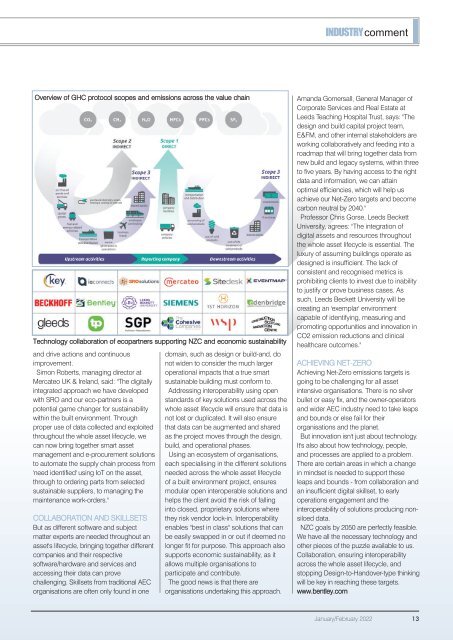You also want an ePaper? Increase the reach of your titles
YUMPU automatically turns print PDFs into web optimized ePapers that Google loves.
INDUSTRYcomment<br />
Overview of GHC protocol scopes and emissions across the value chain<br />
Technology collaboration of ecopartners supporting NZC and economic sustainability<br />
and drive actions and continuous<br />
improvement.<br />
Simon Roberts, managing director at<br />
Mercateo UK & Ireland, said: "The digitally<br />
integrated approach we have developed<br />
with SRO and our eco-partners is a<br />
potential game changer for sustainability<br />
within the built environment. Through<br />
proper use of data collected and exploited<br />
throughout the whole asset lifecycle, we<br />
can now bring together smart asset<br />
management and e-procurement solutions<br />
to automate the supply chain process from<br />
'need identified' using IoT on the asset,<br />
through to ordering parts from selected<br />
sustainable suppliers, to managing the<br />
maintenance work-orders."<br />
COLLABORATION AND SKILLSETS<br />
But as different software and subject<br />
matter experts are needed throughout an<br />
asset's lifecycle, bringing together different<br />
companies and their respective<br />
software/hardware and services and<br />
accessing their data can prove<br />
challenging. Skillsets from traditional AEC<br />
organisations are often only found in one<br />
domain, such as design or build-and, do<br />
not widen to consider the much larger<br />
operational impacts that a true smart<br />
sustainable building must conform to.<br />
Addressing interoperability using open<br />
standards of key solutions used across the<br />
whole asset lifecycle will ensure that data is<br />
not lost or duplicated. It will also ensure<br />
that data can be augmented and shared<br />
as the project moves through the design,<br />
build, and operational phases.<br />
Using an ecosystem of organisations,<br />
each specialising in the different solutions<br />
needed across the whole asset lifecycle<br />
of a built environment project, ensures<br />
modular open interoperable solutions and<br />
helps the client avoid the risk of falling<br />
into closed, proprietary solutions where<br />
they risk vendor lock-in. Interoperability<br />
enables "best in class" solutions that can<br />
be easily swapped in or out if deemed no<br />
longer fit for purpose. This approach also<br />
supports economic sustainability, as it<br />
allows multiple organisations to<br />
participate and contribute.<br />
The good news is that there are<br />
organisations undertaking this approach.<br />
Amanda Gomersall, General Manager of<br />
Corporate Services and Real Estate at<br />
Leeds Teaching Hospital Trust, says: "The<br />
design and build capital project team,<br />
E&FM, and other internal stakeholders are<br />
working collaboratively and feeding into a<br />
roadmap that will bring together data from<br />
new build and legacy systems, within three<br />
to five years. By having access to the right<br />
data and information, we can attain<br />
optimal efficiencies, which will help us<br />
achieve our Net-Zero targets and become<br />
carbon neutral by 2040."<br />
Professor Chris Gorse, Leeds Beckett<br />
University, agrees: "The integration of<br />
digital assets and resources throughout<br />
the whole asset lifecycle is essential. The<br />
luxury of assuming buildings operate as<br />
designed is insufficient. The lack of<br />
consistent and recognised metrics is<br />
prohibiting clients to invest due to inability<br />
to justify or prove business cases. As<br />
such, Leeds Beckett University will be<br />
creating an 'exemplar' environment<br />
capable of identifying, measuring and<br />
promoting opportunities and innovation in<br />
CO2 emission reductions and clinical<br />
healthcare outcomes."<br />
ACHIEVING NET-ZERO<br />
Achieving Net-Zero emissions targets is<br />
going to be challenging for all asset<br />
intensive organisations. There is no silver<br />
bullet or easy fix, and the owner-operators<br />
and wider AEC industry need to take leaps<br />
and bounds or else fail for their<br />
organisations and the planet.<br />
But innovation isn't just about technology.<br />
It's also about how technology, people,<br />
and processes are applied to a problem.<br />
There are certain areas in which a change<br />
in mindset is needed to support these<br />
leaps and bounds - from collaboration and<br />
an insufficient digital skillset, to early<br />
operations engagement and the<br />
interoperability of solutions producing nonsiloed<br />
data.<br />
NZC goals by 2050 are perfectly feasible.<br />
We have all the necessary technology and<br />
other pieces of the puzzle available to us.<br />
Collaboration, ensuring interoperability<br />
across the whole asset lifecycle, and<br />
stopping Design-to-Handover-type thinking<br />
will be key in reaching these targets.<br />
www.bentley.com<br />
<strong>Jan</strong>uary/<strong>Feb</strong>ruary <strong>2022</strong> 13

















